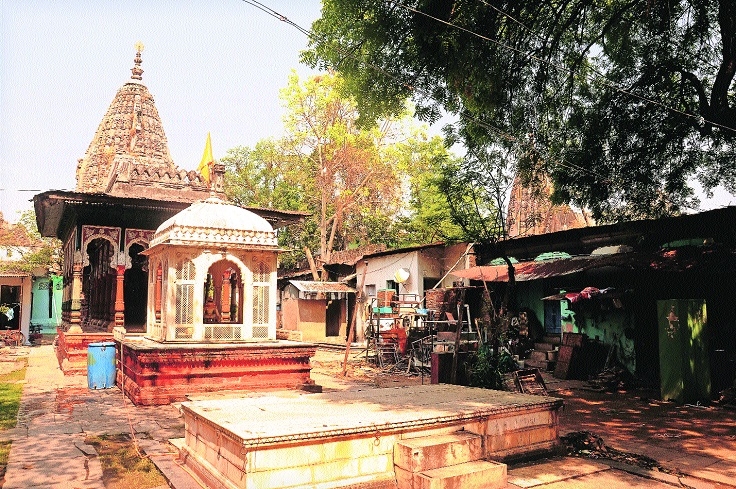Rukmini Temple complex: Withering into oblivion
30 Apr 2023 08:45:22

By Maitrayee Sangitrao :
IN THE narrow lanes opposite Shrimant Deshmukh Wada in Mahal stands a piece of Nagpur’s history. Tucked in the Bhonsla courtyard is Rukmini Temple Complex comprising two prominent temples -- Mahadev Temple also known as Raghu Rajeshwar Temple and Laxmi Narayan Temple named after Rukmini Bai, a courtesan of the Bhonsla royal court. The temple is said to be built during the reign of Raje Raghuji III, the Bhonsla king of Nagpur. Historian Dr B R Andhare writes extensively about the temple in his book ‘Adhunik Nagpur’. This 18th Century marvel is lying in a shambles, crying for attention.
Hidden from the busy streets of Mahal, this imposing complex recreates the grand Bhonsla era. The complex presents a neat blend of Nagara, Maratha, and Dravidian styles of architecture. As one enters the complex, one first comes across Mahadev Temple. It has a very peculiar feature -- the marble Baradari, a gazebo built on a stone plinth. A now-defunct fountain between the temple and the Baradari is another example of the grandeurs of the time.
The courtyard also features two shrines of Lord Ganesh and Bajrang Bali on the sides. From the courtyard of Mahadev Temple, the dilapidating Shikhar of Laxmi Narayan Temple is visible.
The Laxmi Narayan Temple, with spectacular carvings on the spire of the Shikhar and the wooden columns of the Sabha Mandap, is a fascinating example of the finesse
and artistic skills of the
period. A closer look at the Shikhar reveals that elements within the carving
are different on all sides, breaking the monotony. The niches add an edge to the structure with intricate border detailing on nooks and crannies.
The Nagara-style Shikhar with a Maratha-style Mandap and Dravidian-style sub-structures offer a breathtaking amalgam of the three styles, each unique in own way. With intricately carved columns, brackets and ceilings, both these temples are exquisite in the art work.
The architectural style of the temple is the signature style of Nagpur, said, conservation architect Sandeep Pathe. “The peripheral stone wall has a unique composition of niches. The walls that surround the sanctuary of the temple add to the historic quality of the place,” he added.
Considered to be one of the finest temples built in the 18th Century, the temple now is only a sorry shade of its lost glory.
The narrow lanes, fortified walls, and the timelessness of the temples, take one to a breath-taking period in history. One is bound to feel proud of such wonderful heritage. But all one feels is a deep sense of betrayal as these temples are left to wither away. Today, the temple premises are filled with heaps of soil, garbage, junk and all sorts of scrap. The gorgeous wooden Sabha Mandap of Laxmi Narayan Temple, which could have breathed easy with a simple polish, is now painted in bright orange, green, and white, stealing away its old-world charm. Parts of the Shikhar are scraped clean forcing parts of delicate carvings to crumble. Plants now grow on the crannied walls of the temple -- a testimony of such marvelous heritage structure’s poor upkeep.
One can only imagine the glory of the structure with brown wood against the sandstone and marble in the courtyard. For, the place is completely robbed of its structural grandeur. Clothes are left to dry on the Shikhar while the Sabha Mandap is being used as store-room by the people living inside the temple complex. So much for the heritage!
Ironically, these very people are also the sole caretakers of the complex, with responsibility to ensure that the sanctity of the temple premises is preserved.
After site survey, when ‘The Hitavada’ spoke to professionals in the field, discussing the condition of the temple complex, they brought to attention the various issues concerning the preservation and conservation of the temple. “It is absolutely painful how the place is being treated today. Unfortunately, the authorities concerned are unaware of these places, making it harder to even start a dialogue on preservation and conservation,” lamented Amol Wanjari, Architect and Co-founder of Orange Odyssey, a tour agency.
Nagpur@2025, recently, conducted a cleanliness drive and a heritage walk in the precinct to create awareness about the city’s heritage.
Malhar Deshpande, CEO, Nagpur@2025, said, “Most of the heritage sites are privately owned. Administration does not usually take up activities like these on privately owned land. However, this is heritage. A collective effort by the stakeholders along with the locals and authorities is necessary. When everybody works together, solutions come easy.”
Broadening the concept of ownership of history and city’s heritage, conservation architect Shivani Sharma said, “These temples might legally be owned by individual bodies but morally, they belong to society. There is a strong need of capacity-building in all stakeholders associated with the site in whatever capacity, be it the Government officials, or the common man.”
To lose a part of history to human ignorance, neglect, and apathy will lead to descent of city’s history and heritage into a forgotten past. “The temple is an example of the style popularised by the Bhonslas. The temple signifies an important aspect of the Bhonsla court. It is not just about the temple architecture but also about the woman it is named after -- Rukmini Bai, a courtesan. A courtesan held much wealth and respect in the royal court. We don’t just save the structure but a prominent piece of narrative,” added history researcher Atharva Shivankar.
Despite time, nature, human interference and ignorance, the Rukmini Temple complex stands tall. The city cannot afford to be neglectful in preserving its heritage. A wonderful part of Nagpur’s history cannot be allowed to wither in oblivion.
